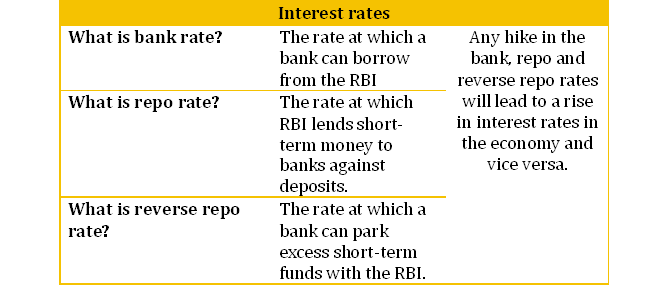Reserve Bank of India
Establishment:
The Reserve Bank of India was established in 1935 under the provisions of the Reserve Bank of India Act, 1934 in Calcutta, eventually moved permanently to Mumbai. Though originally privately owned, was nationalized in 1949.
Organisation and Management:
The Reserve Bank”s affairs are governed by a central board of directors. The board is appointed by the Government of India for a period of four years, under the Reserve Bank of India Act.
- Full-time officials : Governor and not more than four Deputy Governors. The current Governor of RBI is Mr. Urjit Pattel.
There are 3 Deputy Governors presently – B P Kanungo, N S Vishwanathan and Viral V Acharya. - Nominated by Government: ten Directors from various fields and two government Officials
- Others: four Directors – one each from four local boards
Main Role and Functions of RBI
- Monetary Authority: Formulates, implements and monitors the monetary policy for A) maintaining price stability, keeping inflation in check ; B) ensuring adequate flow of credit to productive sectors.
- Regulator and supervisor of the financial system: lays out parameters of banking operations within which the country”s banking and financial system functions for- A) maintaining public confidence in the system, B) protecting depositors’ interest ; C) providing cost-effective banking services to the general public.
- Regulator and supervisor of the payment systems: A) Authorises setting up of payment systems; B) Lays down standards for working of the payment system; C)lays down policies for encouraging the movement from paper-based payment systems to electronic modes of payments. D) Setting up of the regulatory framework of newer payment methods. E) Enhancement of customer convenience in payment systems. F) Improving security and efficiency in modes of payment.
- Manager of Foreign Exchange: RBI manages forex under the FEMA- Foreign Exchange Management Act, 1999. in order to A) facilitate external trade and payment B) promote the development of foreign exchange market in India.
- Issuer of currency: RBI issues and exchanges currency as well as destroys currency & coins not fit for circulation to ensure that the public has an adequate quantity of supplies of currency notes and in good quality.
- Developmental role : RBI performs a wide range of promotional functions to support national objectives. Under this it setup institutions like NABARD, IDBI, SIDBI, NHB, etc.
- Banker to the Government: performs merchant banking function for the central and the state governments; also acts as their banker.
- Banker to banks: An important role and function of RBI is to maintain the banking accounts of all scheduled banks and acts as the banker of last resort.
- An agent of Government of India in the IMF.
Offices and Training Centres:
- RBI has 20 regional offices, most of them in state capitals and 11 Sub-offices. So, the RBI has its offices at 31 locations.
- Has five training establishments – Two, College of Agricultural Banking and Reserve Bank of India Staff College are part of the Reserve Bank. Other three are autonomous, National Institute for Bank Management; Indira Gandhi Institute for Development Research (IGIDR); Institute for Development and Research in Banking Technology (IDRBT).
Instruments of Monetary Policy of RBI :
As discussed earlier, RBI executes Monetary Policy for Indian Economy. The RBI formulates, implements and monitors the monetary policy. The Monetary Policy Committee (MPC) is entrusted with the task of fixing the benchmark policy interest rate (repo rate) for inflation targeting.
The main objectives of monitoring monetary policy are:
- Maintaining price stability while keeping in mind the objective of growth
- Inflation control (containing inflation at 4%, with a standard deviation of 2%)
- Control on bank credit
- Interest rate control
The monetary policy (credit policy) of RBI involves the two instruments given in the flow chart below:
Quantitative Measures
Quantitative measures refer to those measures that affect the variables, which in turn affect the overall money supply in the economy.
Instruments of quantitative measures:
Bank rate
The rate at which central bank provides loan to commercial banks is called bank rate. This instrument is a key at the hands of RBI to control the money supply in long term lending. At present it is 6.25%.
- Increase in the bank rate will make the loans more expensive for the commercial banks; thereby, pressurizing the banks to increase the rate of lending. The public capacity to take credit at increased rates will be lower, leading to a fall in the volume of credit demanded.
- The reverse happens in case of a decrease in the bank rate. This increases the lending capacity of banks as well as increases public demand for credit and hence will automatically lead to a rise in the volume of credit flowing in the economy.
- This rate has been aligned to the MSF rate and hence, changes automatically with the MSF rate changes alongside policy repo rate changes.

Liquidity Adjustment Facility-
Reserve Bank of India’s LAF helps banks to adjust their daily liquidity mismatches. LAF has two components – repo (repurchase agreement) and reverse repo.
(i) Repo Rate: Repo (Repurchase) rate is the rate at which the RBI lends short-term money to the banks against securities. When the repo rate increases borrowing from RBI becomes more expensive.Repo rate is always higher than the reverse repo rate. At present it is 6.00%
(ii) Reverse Repo Rate: It is the exact opposite of repo. In a reverse repo transaction, banks purchase government securities form RBI and lend money to the banking regulator, thus earning interest. Reverse repo rate is the rate at which RBI borrows money from banks.The banks use this tool when they feel that they are stuck with excess funds and are not able to invest anywhere for reasonable returns. At present it is 5.75%
(iii)Marginal Standing Facility (MSF): was introduced by the Reserve Bank of India (RBI) in its Monetary Policy (2011-12). The MSF would be a penal rate for banks and the banks can borrow funds by pledging government securities within the limits of the statutory liquidity ratio SLR.
The scheme has been introduced by RBI for reducing volatility in the overnight lending rates in the inter-bank market and to enable smooth monetary transmission in the financial system. Currently, it is 6.25%
Varying reserve ratios –
The reserve ratio determines the reserve requirements that banks are liable to maintain with the central bank. These tools are:
(i) Cash Reserve Ratio (CRR)
It refers to the minimum amount of funds in cash( decided by the RBI) that a commercial bank has to maintain with the Reserve Bank of India, in the form of deposits. An increase in this ratio will eventually lead to considerable decrease in the money supply. On the contrary, a fall in CRR will lead to an increase in the money supply. Currently, it is 4%.
(ii) Statuary Liquidity Ratio (SLR)
SLR is concerned with maintaining the minimum percentage( fixed by RBI) of assets in the form of non-cash with itself. The flow of credit is reduced by increasing this liquidity ratio and vice-versa. As SLR rises the banks will be restricted to pump money in the economy, thereby contributing towards a decrease in money supply. The reverse case happens if there is a fall in SLR, it increases the money supply in the economy. Currently, SLR is 19.5%.
Open Market Operations (OMOs)
These include both, outright purchase and sale of government securities, for both, injection and absorption of liquidity in the economy.
Market Stabilisation Scheme (MSS)
This instrument was introduced in 2004. Surplus liquidity of a more enduring nature arising from large capital inflows is absorbed through sale of short-dated government securities and treasury bills. The cash so mobilised is held in a separate government account with the Reserve Bank.





